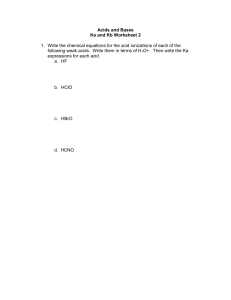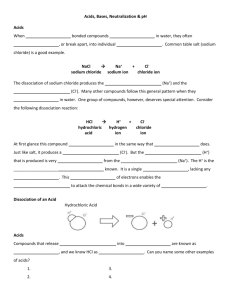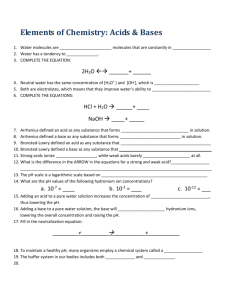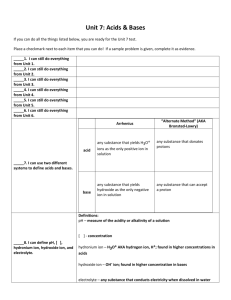Mar 15
advertisement
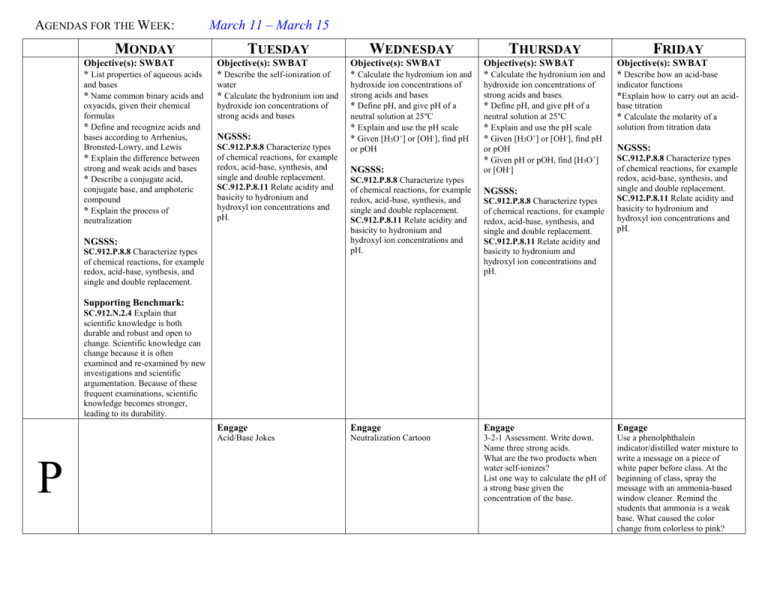
AGENDAS FOR THE WEEK: MONDAY March 11 – March 15 TUESDAY WEDNESDAY THURSDAY FRIDAY Objective(s): SWBAT * List properties of aqueous acids Objective(s): SWBAT * Describe the self-ionization of Objective(s): SWBAT * Calculate the hydronium ion and Objective(s): SWBAT * Calculate the hydronium ion and Objective(s): SWBAT * Describe how an acid-base and bases * Name common binary acids and oxyacids, given their chemical formulas * Define and recognize acids and bases according to Arrhenius, Bronsted-Lowry, and Lewis * Explain the difference between strong and weak acids and bases * Describe a conjugate acid, conjugate base, and amphoteric compound * Explain the process of neutralization water * Calculate the hydronium ion and hydroxide ion concentrations of strong acids and bases hydroxide ion concentrations of strong acids and bases * Define pH, and give pH of a neutral solution at 25°C * Explain and use the pH scale * Given [H3O+] or [OH-], find pH or pOH hydroxide ion concentrations of strong acids and bases. * Define pH, and give pH of a neutral solution at 25°C * Explain and use the pH scale * Given [H3O+] or [OH-], find pH or pOH * Given pH or pOH, find [H3O+] or [OH-] indicator functions *Explain how to carry out an acidbase titration * Calculate the molarity of a solution from titration data NGSSS: SC.912.P.8.8 Characterize types of chemical reactions, for example redox, acid-base, synthesis, and single and double replacement. SC.912.P.8.11 Relate acidity and basicity to hydronium and hydroxyl ion concentrations and pH. NGSSS: SC.912.P.8.8 Characterize types of chemical reactions, for example redox, acid-base, synthesis, and single and double replacement. NGSSS: SC.912.P.8.8 Characterize types of chemical reactions, for example redox, acid-base, synthesis, and single and double replacement. SC.912.P.8.11 Relate acidity and basicity to hydronium and hydroxyl ion concentrations and pH. NGSSS: SC.912.P.8.8 Characterize types of chemical reactions, for example redox, acid-base, synthesis, and single and double replacement. SC.912.P.8.11 Relate acidity and basicity to hydronium and hydroxyl ion concentrations and pH. NGSSS: SC.912.P.8.8 Characterize types of chemical reactions, for example redox, acid-base, synthesis, and single and double replacement. SC.912.P.8.11 Relate acidity and basicity to hydronium and hydroxyl ion concentrations and pH. Supporting Benchmark: SC.912.N.2.4 Explain that scientific knowledge is both durable and robust and open to change. Scientific knowledge can change because it is often examined and re-examined by new investigations and scientific argumentation. Because of these frequent examinations, scientific knowledge becomes stronger, leading to its durability. P Engage Engage Engage Engage Acid/Base Jokes Neutralization Cartoon 3-2-1 Assessment. Write down. Name three strong acids. What are the two products when water self-ionizes? List one way to calculate the pH of a strong base given the concentration of the base. Use a phenolphthalein indicator/distilled water mixture to write a message on a piece of white paper before class. At the beginning of class, spray the message with an ammonia-based window cleaner. Remind the students that ammonia is a weak base. What caused the color change from colorless to pink? L Explore Explore Explore Go over chapter 14 test Interactive question and answer of page 502 Interactive question and answer of pages 505 and 506. Interactive question and answer of pages 508. Explain Explain Explain Discuss the pH scale and pH/pOH calculations using hydronium ion concentration, hydroxide ion concentration, and concentration of solutions. Discuss calculating hydronium ion and hydroxide ion concentrations from pH. Discuss indicators and how to do a titration. Have students follow along in book on pages 515 to 520. Elaborate Elaborate Assign practice on page 508. Assign practice on page 520 and 521. Discuss titration lab for Monday. Explain Test A N Explore Begin acid/base calculations. Discuss self-ionization of water and how to calculate the hydronium ion and hydroxide ion concentrations using Kw for strong acids and bases. Elaborate Elaborate Assign practice on page 502 Assign practice on pages 505 and 506. Evaluate and Summary Evaluate and Summary Evaluate and Summary Evaluate and Summary Evaluate and Summary Test and lab notebooks collected and graded. Informal assessment of student responses. Informal assessment of student responses. Informal assessment of student responses. Engagement responses collected. Informal assessment of student responses. Chapter 14 Test Graded Chapter 14 Test Textbooks, neutralization cartoon Textbooks, sticky notes Textbooks, phenolphthalein indicator, distilled water, white paper, ammonia-based window cleaner, goggles Resources: Jokes: Q: Why do chemistry professors like to teach about ammonia? A: Because it's basic stuff. What instrument does a chemist play? A conjugate bass




